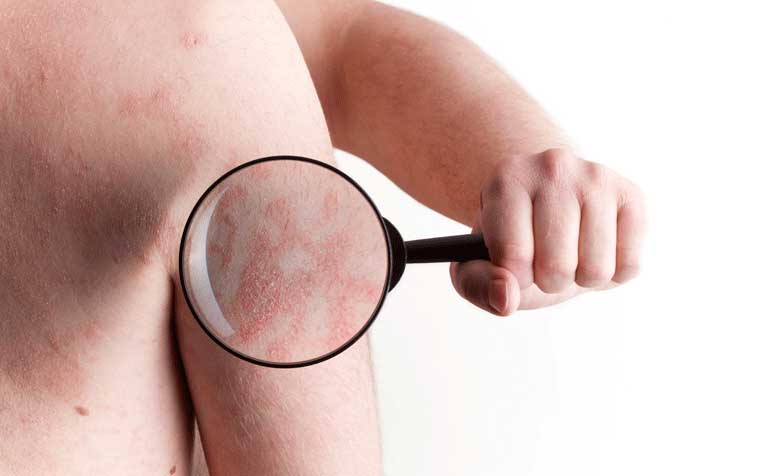
Psoriasis is charaterised by thick red patches with flaky silvery scales.
Psoriasis is a chronic skin condition characterised by thick red patches with flaky silvery scales.
Psoriasis can be mistaken for dandruff when occurring on the scalp. Besides the scalp, psoriasis can affect any part of the skin, in particular the:
Knees
Elbows,
Hands,
Feet and
Lower back
In severe cases, the patches can be accompanied by painful joint swelling as well as joint disfigurement.
“Psoriasis patches can range from minor dandruff-like scaling to major eruptions covering large areas of skin,” says Clinical Associate Professor Pang Shiu Ming, Senior Consultant from the Department of Dermatology at Singapore General Hospital (SGH), a member of the SingHealth group.
“In its severe form, psoriasis can be incapacitating, significantly affecting the patient’s quality of life. On rare occasions, very severe psoriasis can be life-threatening.”
Psoriasis is a common skin problem affecting one to two percent of the population. In Singapore, an estimated 40,000 people suffer from the disease, according to the Psoriasis Association of Singapore.
Psoriasis affects men and women in equal numbers and may appear for the first time at any age. It does however start more frequently between the ages of 15 and 45, particularly during puberty and menopause. Psoriasis may appear in children.
Common triggers for psoriasis flare-ups
The following factors have been found to be triggers for psoriasis flare-ups:
Skin or nail injury
Stress and anxiety
Infections such as a streptococcal (bacterial) throat infection
Certain medications such as antimalarial drugs or lithium
Exposure to cold
Overweight and obesity
Excessive alcohol consumption
Smoking
“Smoking is a risk factor for psoriasis and has also been found to increase the severity of symptoms,” says Clin Assoc Prof Pang.
Mild and moderate psoriasis: How to manage
Skin trauma and friction should be minimised. Skin should be well moisturised with regular emollients. This should be applied on the whole body.
Topical treatments include:
- Coal tar preparations (cream or shampoo)
- Dithranol cream/ointment
- Salicylic acid ointment
- Corticosteroids cream/ointment
- Vitamin D-type drugs such as calcipotriol and calcitriol cream/ointment
- Fixed dose combination of corticosteroid and calcipotriol ointment/gel
- Fixed dose combination of corticosteroid and salicylic acid ointment
Severe psoriasis: How to manage
More severe psoriasis may require treatment with phototherapy using ultraviolet light 2-3 times a week for a period of several weeks to several months.
Phototherapy can produce side effects such as dryness and burns on the skin, and increases the risk of skin cancer.
Although phototherapy with ultraviolet light is used in the treatment of psoriasis, you are advised to take care to protect yourself from the damaging effects of the sun.
Persistent psoriasis may require oral and/or injectable medication as well as topical creams and ointments.
Since oral and injectable medication presents risks to internal organs such as the kidney and liver as well as the immune system, this psoriasis treatment needs to be closely monitored.
“Psoriasis treatment involving oral and injectable medication and phototherapy can have side effects and the patient needs to be monitored with regular blood tests and follow-up visits,” says Clin Assoc Prof Pang.
Psoriasis symptoms
Most psoriasis patients have mild to moderate symptoms which are likely to wax and wane, appearing and disappearing in cycles. Psoriasis symptoms may flare up for a few weeks or months and then disappear for some time, even going into remission for some years. However, in most cases, the psoriasis symptoms do eventually recur.
A small number of patients suffer from the severe and persistent form of the skin disease.
Mild and moderate psoriasis symptoms include:
Dry cracked skin prone to bleeding
Burning, itchy skin
Raised red patches with silvery scales (called plaque)
Severe psoriasis symptoms include:
Inflamed and itchy patches covering large areas of skin
Stiff, swollen and painful joints
Disfigured joints, commonly fingers and toes
Thickened, discoloured nails which may separate from the nail beds
3 Types of psoriasis
The most common type of psoriasis is plaque psoriasis, in which patches can occur anywhere on the body. Other common types include nail psoriasis and scalp psoriasis.
Less common types include guttate psoriasis; localised pustular psoriasis; acropustulosis, palmoplantar pustulosis, palmoplantar psoriasis; and inverse or flexural psoriasis. Erythrodermic psoriasis and generalised pustular psoriasis (Von Zumbusch) are life-threatening forms of psoriasis.
In psoriatic arthritis, a disorder of the immune system that affects the skin and joints, it can lead to joint pain, stiffness, swelling and joint deformity.
Causes of psoriasis
Psoriasis is believed to be caused by a combination of genetic and environmental factors which affect the body’s immune system, causing its T-cells to attack healthy skin cells.
“A family history of psoriasis puts you at greater risk of getting the disease,” says Clin Assoc Prof Pang.
The disease occurs when skin cells multiply rapidly, replacing old skin cells over 3-4 days instead of the normal 3-4 weeks. This rapid multiplication causes the cells to build up on the surface of the skin, forming thick patches.
Avoid triggers and lead a healthy lifestyle to prevent psoriasis relapse
Psoriasis is a chronic non-infectious skin condition which can’t be cured. However, symptoms, particularly in mild cases, can be controlled with topical creams, ointments and medication.
“Avoiding triggers such as stress, and leading a healthy lifestyle, can also prevent a relapse of psoriasis symptoms,” advised Assoc Prof Pang.
Ref: L20
Related articles:
Psoriasis Treatment: Tips to Prevent Relapse


















 Get it on Google Play
Get it on Google Play